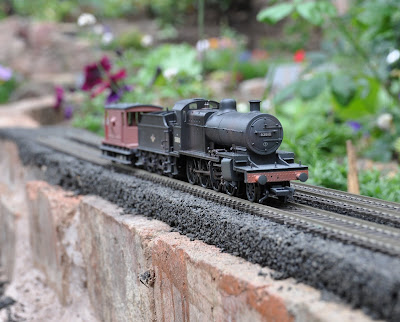The good news is that I have done a lot more testing, run trains over the viaduct (on the final trackbed but with temporary track), and extended the trackbed up to the tunnel entrance.
One of the tests involved running a train up the steepest section, with increasing numbers of coaches, with and without a pilot. Without a pilot, the best it could do was 4 before it started losing traction on the rails.With a pilot, they managed 8, still with some slipping from Tangmere. I stopped at 8, when smoke started coming out of the pilot engine! (...and it wasn't the paintshop smoke seen in the pictures below.)
 |
| 34067 "Tangmere" piloted by 2P 40579 (still in LMS livery) on a heavy cross-country train. |
 |
40579 and 34067 approach the viaduct, working hard up the gradient.
The troublesome increase in gradient can be seen between the green and red/cream coaches. |
 |
| 4F 44417 on the viaduct with an anachronistic ballast train. |
 |
| View from a 00 microlight above the viaduct, looking along the trackbed towards the site of the tunnel mouth. |
And the bad news? Well, the poor performance of the locos on the steepest gradient is the clue. I re-checked the gradient and found I had been somewhat over-optimistic in the measurements during construction, and instead of 1 in 50 with a short stretch of 1 in 40, I had about 2 metres of 1 in 40 with a short stretch of 1 in 33. This makes a big difference to the length of trains that can be handled.
What am I going to do about it? For now, I'll leave the track in place but won't extend it to double track. This will allow trains to be run and the weather-resistance of the track to be tested. Any new track further down-hill will have the trackbed raised so that eventually the existing track can be replaced with a maximum gradient of 1 in 50, as originally intended. The viaduct and the stretch up to the tunnel do not exceed 1 in 50.










